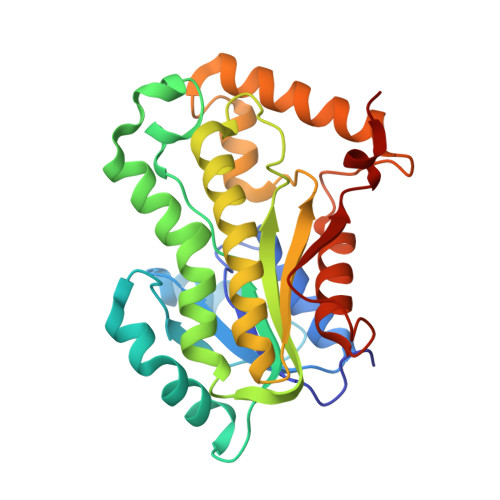Towards a new tuberculosis drug: pyridomycin - nature's isoniazid.
Hartkoorn, R.C., Sala, C., Neres, J., Pojer, F., Magnet, S., Mukherjee, R., Uplekar, S., Boy-Rottger, S., Altmann, K.H., Cole, S.T.(2012) EMBO Mol Med 4: 1032-1042
- PubMed: 22987724
- DOI: https://doi.org/10.1002/emmm.201201689
- Primary Citation of Related Structures:
4DQU, 4DRE, 4DTI - PubMed Abstract:
Tuberculosis, a global threat to public health, is becoming untreatable due to widespread drug resistance to frontline drugs such as the InhA-inhibitor isoniazid. Historically, by inhibiting highly vulnerable targets, natural products have been an important source of antibiotics including potent anti-tuberculosis agents. Here, we describe pyridomycin, a compound produced by Dactylosporangium fulvum with specific cidal activity against mycobacteria. By selecting pyridomycin-resistant mutants of Mycobacterium tuberculosis, whole-genome sequencing and genetic validation, we identified the NADH-dependent enoyl- (Acyl-Carrier-Protein) reductase InhA as the principal target and demonstrate that pyridomycin inhibits mycolic acid synthesis in M. tuberculosis. Furthermore, biochemical and structural studies show that pyridomycin inhibits InhA directly as a competitive inhibitor of the NADH-binding site, thereby identifying a new, druggable pocket in InhA. Importantly, the most frequently encountered isoniazid-resistant clinical isolates remain fully susceptible to pyridomycin, thus opening new avenues for drug development. ¡úSee accompanying article http://dx.doi.org/10.1002/emmm.201201811.
Organizational Affiliation:
Ecole Polytechnique F¨¦d¨¦rale de Lausanne, Global Health Institute, Lausanne, Switzerland.















